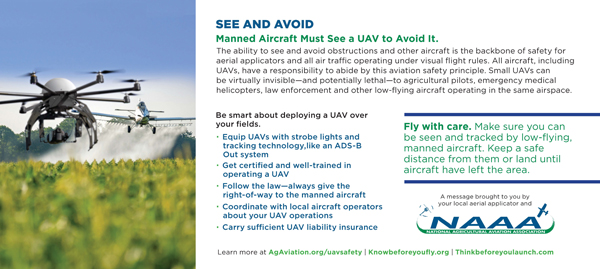ALEXANDRIA, VA – April 18, 2022 – As the nation enters the upcoming growing season, the National Agricultural Aviation Association (NAAA) is asking all unmanned aircraft (UA) operators to be mindful of low-altitude manned agricultural aircraft operations.
Agricultural aviators treat 127 million acres of cropland in the United States each year and perform a variety of services that help farmers increase productivity and protect their crops.
“With Russia’s invasion of Ukraine restricting a huge portion of the world’s food supply, we cannot afford even a small disruption in the nation’s food supply chain,” NAAA CEO Andrew Moore said. “Agricultural aviators deliver nutrients, seeds and crop protection products to crops that will become consumers’ food and fiber supply in the U.S. and around the world. Their work cannot be delayed because of an unmanned aircraft not yielding to them, as is required by law. 2021 was a big year for aerial applicators, and we expect demand for aerial application services to be even higher in 2022.”
Agricultural aviators fly as low as 10 feet off the ground, meaning they share airspace with UAs that are restricted to flying no more than 400 feet above ground level. For this reason, NAAA urges UA operators to do everything they can to avoid ag aircraft doing important low-altitude work.
NAAA recommends that unmanned aircraft operators:
- Give the right of way to a manned aircraft. It’s the law.
- Equip drones with tracking technology, such as ADS-B In, so you will know ADS-B Out-equipped manned aircraft positions.
- Get certified and well-trained in operating an unmanned aircraft.
- Contact local agricultural aviation operations before flying by consulting AgAviation.org/findapplicator.
- Equip UAs with visible strobe lights and high visibility marking.
- Land your unmanned aircraft immediately when a low-flying aircraft is nearby.
- Carry UA liability insurance.
Small UAs can be virtually invisible—and potentially lethal—to agricultural aviators, air ambulance helicopters, law enforcement and other low-flying manned aircraft operating in the same airspace. In a test conducted by the Colorado Agricultural Aviation Association and other stakeholders, including manned and unmanned aircraft organizations, and the state of Colorado, no pilot operating a manned aircraft could continuously visually track a 28-inch-wide drone when flying at regular speeds. While they might be spotted for a second, UAs are not constantly visible to pilots, meaning it is up to the drone operator to avoid a collision.
When birds hit an ag aircraft, they can break through an aircraft’s windshield, causing deadly accidents. A study conducted by the Alliance for System Safety of UAS through Research Excellence (ASSURE) showed UA collisions with aircraft cause more damage than a bird strike of comparable size would, due partially to unmanned aircraft’s dense motors and batteries, as opposed to a bird made mostly of water, feathers, hollow bones and sinew.
At this moment when we’re all depending on the continued safe, affordable and abundant supply of food, fiber and bioenergy, don’t forget America’s agricultural aviators are working in the skies to help farmers produce their crops. Manned ag aircraft are also flying at low altitudes to combat fires and conduct public health applications to eradicate disease-carrying mosquitoes and other deadly pests. If you’re going to fly an unmanned aircraft this summer, please be responsible and do everything you can to avoid agricultural aircraft. Learn more at AgAviation.org/uavsafetycampaign and Knowbeforeyoufly.org.







